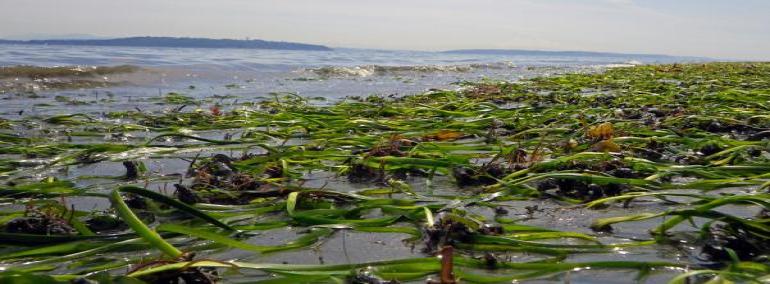STATEWIDE KELP AND EELGRASS HEALTH AND CONSERVATION PLAN
In response to dramatic loss of kelp and eelgrass in Washington, the State Legislature passed Senate Bill 5619, which was signed into law in March of 2022 (RCW 79.135.440). The law directs the Department of Natural Resources to create a statewide Kelp Forest and Eelgrass Meadow Health and Conservation Plan.
The goal of this plan is to conserve and restore at least 10,000 acres of kelp forest and eelgrass meadow habitat by 2040, advancing high-priority strategies identified in both the Puget Sound Kelp Conservation and Recovery Plan and the Puget Sound Eelgrass Recovery Strategy. DNR will develop this plan through a collaborative planning process to proactively assess and prioritize areas for coordinated conservation and restoration activities of kelp forests and eelgrass meadows throughout the Puget Sound and along the Washington Coastline.
DNR will:
- Build on existing research to map and prioritize areas in decline, and areas where restoration may be possible and would most benefit nearshore ecosystem function;
- Identify potential stressors impacting the health and vitality of kelp forests and eelgrass meadows in order to improve effectiveness of conservation and restoration efforts;
- Collaborate with Tribal Nations and other regional partners on identifying coordinated actions and success measures; and
- Continue to track the abundance and distribution of kelp forests and eelgrass meadows to evaluate the success measures and to inform adaptive management of the plan and actions
The Kelp Forest and Eelgrass Meadow Health and Conservation Prioritization Plan (Prioritization Plan) outlines the process to prioritize at least 10,000 acres of kelp and eelgrass habitat by 2040 through a collaboratively developed framework.
The Prioritization Plan outlines a broad statewide process to identify high value habitat, followed by sub-basin scale engagement for local identification of priority areas. The outputs of this draft plan represent the first step of using more coarse, high-level data at the state scale, and will be followed starting in 2024 with additional engagement to integrate high-context, region-specific knowledge, and data at the sub-basin scale.
Our next steps will be initially focused on three sub-basins for additional engagement and site selection, however DNR intends to engage in conversations about conservation and recovery in all sub-basins as we work toward our 10,000-acre goal.
As a companion document to the Prioritization Plan, the Kelp Forest and Eelgrass Meadow Health and Conservation Monitoring Plan (Monitoring Plan) aims to guide assessment of kelp and eelgrass habitat conservation and recovery efforts, track progress, and adapt strategies over time to achieve the long-term goal of conserving and recovering these vital ecosystems.
The Monitoring Plan has several objectives:
- Identify WA DNR performance metrics to track statewide progress - reported biennially.
- Describe existing statewide monitoring programs to provide context on habitat distribution, trends, stressors, and recovery.
- Support management of monitoring, conservation, and recovery efforts at statewide and local scales.
The statewide Kelp Forest and Eelgrass Meadow Health and Conservation Plan will be developed through a collaborative planning process to proactively assess and prioritize areas for coordinated conservation and restoration activities of kelp forests and eelgrass meadows throughout the Puget Sound and along the Washington Coastline. To guide this collaborative process, DNR created the Kelp and Eelgrass Engagement Plan which identified the pathways, tools, and opportunities for engagement of tribes, the public, and stakeholders in development of the Statewide Kelp Forest and Eelgrass Meadow Health and Conservation Plan.
BACKGROUND

Kelp forests and eelgrass meadows are diverse and productive nearshore ecosystems, providing critical habitat for a wide array of marine life, including threatened and endangered species such as salmon, rockfish, and abalone. These marine forests and meadows play an important role in climate mitigation and adaptation by sequestering carbon and relieving ocean acidification. In addition to these ecological benefits, kelp and eelgrass have important cultural value to Northwest Tribal Nations, playing a prominent role in traditional fishing, hunting, and food preparation and storage.
As the steward of these vital nearshore habitats, DNR has been tracking long-term trends of kelp forests and eelgrass meadows and has identified areas of concerning losses for both habitats. In particular, bull kelp in South and Central Puget Sound regions declined by more than 90% in the last 150 years, according to recent analyses. Eelgrass meadows in the San Juan Islands have seen severe declines as well, in just the last 20 years. Changes in the abundance or distribution of these habitats likely reflect changes in environmental conditions, and will require collective action across partnering agencies, Tribes, organizations and communities to support future ecosystem health.
RECENT CONSERVATION EFFORTS
DNR has already taken steps toward advancing conservation of kelp and eelgrass through the creation of the Kelp and Eelgrass Protection Zone near Everett in March 2022. Read more about the Snohomish Kelp and Eelgrass Protection Zone here.
ADDITIONAL RESOURCES
DNR Aquatic Sciences



